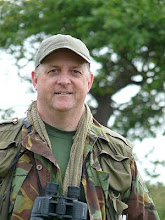Recently I have been tackling oil painting and, in order to get a proper grip of the techniques and processes involved I have been painting quite a lot of small study type pieces before tackling something larger or more compositionally considered.
One of these pieces is this 10"x8" of a male House Sparrow feeding on seeds on the top of a wall. I have a hankering to paint a whole group of Sparrows hopping about together and this is just for me to get a first feel for the idea. Incidentally, the collective noun for Sparrows is actually 'Host' so I should say a 'Host of Sparrows' which makes them sound rather like Angels! I like that idea.
Jo over at
'A scent of chocolate' was confused as the the bird's identity. Fair enough I thought, although she's a nature lover, she's not a birdwatcher so I enlightened her. We then got into a discussion about the colour of the Sparrow's breast and belly area. She said that she didn't remember a British bird like that and it turns out that what was causing the confusion was that she was seeing a bird with blue feathers whereas I was seeing a bird with grey feathers.
I thought it might have been a monitor problem and told her, jokingly, that she might want to adjust hers, but she tried viewing it on different screens and saw the same thing on all three so she asked; 'The bird isn't blue so why did you paint it that way?'
The file I posted was a photograph of the painting that I took when it was first completed because, obviously I couldn't scan it with still wet paint. This has, admittedly, caused a slightly blueish colour cast over the whole thing which probably hasn't helped the issue but it's not too far off. She asked others to comment on the colour of the bird and it seems that some agree with her saying that the bird is blue. By the way, can we ignore what someone described as the 'puky'
(sic) green in the background! I plan to use something different for the bigger piece because I agree that the grey green isn't going to work, (which is one of the reasons for doing these little prep studies).
Now, green issues aside, all this set me thinking so I did a little experiment.
Using photoshop I investigated the colour breakdown on the photo. The actual colour breakdown of the bird's chest and belly area is, on average, around 50% cyan (blue) and 50% magenta (red). So the colour of the pic is essentially a purple/blue. A Sparrow's chest and belly feathers are generally described as simply 'grey'. This obviously varies with individuals and our perception of the 'colour' will vary with factors such as the environment, the ambient and direct lighting around the subject, whether the feathers are wet or dry and so on.
So why
did I paint the bird that colour?
I don't use black in my paintings, it's just too flat and it tends to 'kill' any life in the painting so the grey tones (strictly speaking grey is achromatic) created using just black and white can be very 'flat' looking. To combat this effect I, in common with many other artists, use a combination of Ultramarine blue and Burnt umber (brown) to create my 'black'. Once I start adding white to this mix I get 'greys' which are inevitably blue or red tinted (cool or warm). In general, shadow areas tend towards being cooler so my natural inclination is to lean towards the blue when painting them. I do sometimes use a touch of Dioxazine purple for shadows but, as I didn't in this instance, we'll leave that for some other time.
I think what it boils down to is; the bird is 'grey', the paint used to represent that 'grey' is blue, red and white. If you know the local colour of a thing then that's the colour you will see.
So my question would probably be: Why
wouldn't I paint it that colour?
It's all about perception. Take a look at the work of an artist that I consider to be a master;
http://sosa2.com/Birds/index2.php Check out the Rock Ptarmigans in the lower left corner. Not one of these birds is white. They are a glorious mix of purple, blue, pink and yellow cream, and yet it's perfectly obvious that they are 'white' birds.
What colour is snow? It's white isn't it? Have a look at another Sosa painting:
http://sosa2.com/Birds/index5.php 'Woodcock II'. This snow is blue, purple, lilac, yellow, pink, but the colour you perceive overall is still 'white' because you know that snow is white.
Here's another one, take a look at my Peregrine painting, 'Commanding presence', from a while ago. On a Peregrine's head is a 'hood' of dark grey, its chest and belly are a creamy 'white' (once again this is a generalisation). But because of the way the sunlight affects our perception of colour I have used the same dark blue for the part of the bird's head that is in the light and the part of the bird's body that is in shadow and yet I hope that this conveys a sense of the light rather than indicating that the local colour is blue in either case.
There's tons of 'stuff' that's been written about colour, some of it fanciful, some of it scientific, some of it, I'm sure, is utter nonsense, and some of it, I'm equally sure, makes perfect sense. Somewhere in the back of my head when I'm painting I'm probably aware of everything I've read and everything I've seen about all this 'stuff' but in the end I just go with what feels right to me and, as an artist, that's surely the way it should be?
